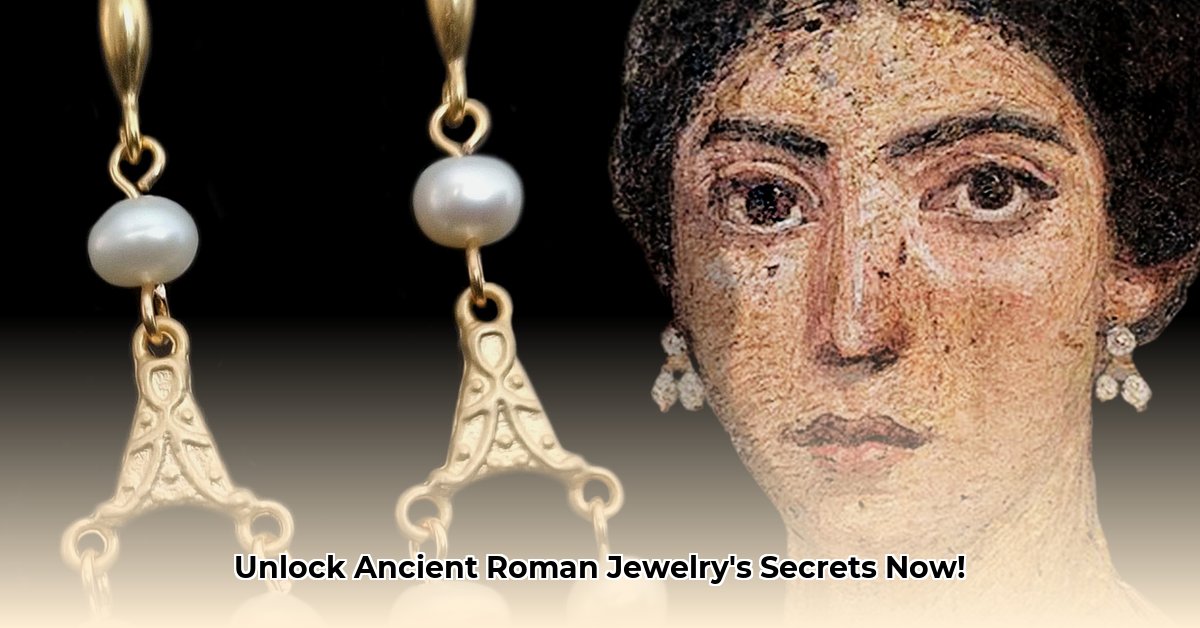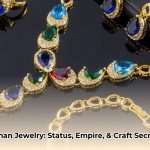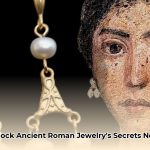Ancient Roman jewelry offers a captivating window into a powerful empire, reflecting the social priorities, profound beliefs, and remarkable artistry of its people. Far beyond mere adornment, each piece served as a deliberate statement—a declaration of identity, status, and connection within Roman society. What truly set Roman adornments apart was their profound love for vibrant color, a stark contrast to their Greek predecessors, who often emphasized the intrinsic beauty of the metal itself. This Roman fascination with hue was beautifully realized through an expansive array of imported gemstones and ingenious glasswork. Learn more about their fascinating jewelry styles.
The narrative of Roman jewelry is intrinsically linked to the empire’s expansion. As Rome conquered vast Mediterranean territories, it gained unparalleled access to natural resources and established extensive trade networks. This allowed for the influx of both semi-precious and precious stones from distant lands, enriching the jeweler’s palette and enabling an unprecedented level of opulence in design.
The Social Tapestry Woven in Gold and Glass
Roman trinkets played various roles, speaking volumes about an individual’s position and wealth. Styles and materials evolved, absorbing influences from the myriad cultures the Romans encountered through conquest and trade—including the sophisticated techniques of the Etruscans and the iconic motifs of the Greeks and Egyptians—yet always maintaining a distinctly Roman flair.
A Mirror Reflecting Roman Society
These Roman accessories were potent indicators of status and social hierarchy. While the elite showcased their fortunes with elaborate gold and silver creations, ordinary citizens utilized more accessible Roman materials like bronze and iron. The Romans excelled in early mass-production methods, particularly the widespread use of molds and casting. This innovative approach made jewelry available to a broader populace, transcending the exclusive artisanal creations of earlier eras. Did you know a solid gold snake bracelet, worn without a clasp, was a common Roman fashion statement, symbolizing immortality? This detail highlights their unique blend of luxury and symbolic design.
| Social Class | Material Used | Notable Characteristics |
|---|---|---|
| Wealthy Elite | Gold and Silver, precious gemstones (emeralds, sapphires, diamonds, pearls), intricate glass | Intricate designs, high-quality Roman craftsmanship often incorporating symbolic motifs, large and ostentatious pieces. |
| Middle Class | Silver, bronze, semi-precious stones (garnets, amethysts, jasper), good quality glass | Simpler Roman designs, frequently mass-produced, reflecting current fashion trends while still conveying status. |
| Lower Class | Bronze or Less Expensive Metals, various colored glass beads, bone, jet | Basic designs, primarily functional (like fibulae for fastening garments) or for simple adornment, often mass-produced. |
The Magnetic Charm of Color and Gemstones
The Roman passion for color spurred the extensive use of gemstones and colored Roman glasswork. Garnets (carbunculus) and emeralds (smaragdus) arrived from Egypt, while shimmering onyx and golden amber hailed from regions bordering the Persian Gulf. Amethyst, prized for its purple hue, was imported from India. Pearls, particularly coveted, were sourced from the Red Sea and the Mediterranean, often used in clusters for crotalia (rattling earrings), signifying immense Roman wealth due to their rarity and cost.
Roman artisans masterfully created glass imitations of precious stones, so convincing that distinguishing them from genuine gems without expert knowledge was often challenging. They were pioneers in glassmaking, developing advanced techniques such as millefiori, where intricate multi-colored patterns resembling flowers were incorporated directly into the glass, creating stunning visual effects.
Symbols of Power and Protection
Romans frequently used ornaments not just for beauty but to display prosperity, authority, and knowledge. Noblewomen wore specific pieces to highlight their family’s status and personal achievements, a visual declaration of their lineage. Senators and bureaucrats often sported large gold rings set with prominent gemstones, such as intaglios or cameos, which could also serve as signet rings for sealing important documents. The fibula, a decorative brooch, became a prominent accessory, especially among military personnel and officials, often adorned with elaborate designs reflecting achievements or affiliation.
For the average Roman citizen, iron rings were standard, unless a gold one was bestowed for bravery or distinguished service, a privilege periodically restricted by sumptuary laws to maintain social distinctions. Elite women’s elaborate gold jewelry powerfully symbolized their family’s standing, reflecting their husbands’ positions within the Roman Empire. It was a bold visual representation of success and social standing.
Jewelry: A Matter of Gender, Age, and Property
Roman women generally possessed and wore significantly more jewelry than men. They adorned themselves with diverse earrings (including boat-shaped and crotalia designs), necklaces, bracelets (like coiling snakes), rings (often multiple rings on each finger), and fibulae, often simultaneously. Quintus Horatius Flaccus, a Roman lyric poet, even lamented the sheer volume of jewelry his wife wore, testifying to its prevalence.
Interestingly, and quite progressively for the era, jewelry was considered a woman’s personal property, separate from her husband’s assets, granting them the freedom to buy, sell, bequeath, or barter their pieces. This represented an early form of financial independence and a distinctive aspect of Roman women’s legal standing.
Men typically wore finger rings and fibulae to secure garments, with elaborate gold rings reserved for high-ranking officials and senators, signaling their senatorial rank or equestrian status. Pendants were also worn, sometimes depicting a deity or a portrait of the emperor. The Roman dictator Titus Manlius, known as “Torquatus” for wearing a torc (a stiff neck ring) taken from a defeated Gaul, exemplifies how jewelry could signify military valor and personal achievement.
Children wore amulets, such as the phallic fascinus, believed to ward off the evil eye and protect from malevolent forces. Young elite boys often sported golden bullae—hollow, locket-like amulets containing protective charms—until they reached adulthood, a tradition borrowed and popularized from the Greeks. Even death rituals incorporated Roman jewelry, with the deceased often interred with gold wreaths or diadems, symbolizing their status, achievements in life, or hopes for protection in the afterlife. These grave goods provide invaluable insights into Roman beliefs and material culture.
Craftsmanship, Trade, and the Artisanal Economy
The thriving Roman jewelry industry relied heavily on the empire’s sophisticated network, combining highly skilled Roman craftsmanship with efficient production and far-reaching trade routes.
The Art of Roman Production
The Romans achieved a form of mass production through a combination of strategic practices:
- Division of Labor: Workshops specialized, with some artisans focusing on
metalworking, others ongemstone cuttingand polishing, and still others on final assembly. This specialization increased efficiency and allowed for higher output. - Molds and Dies: Essential tools such as
moldsanddiesallowed for the consistent replication ofpopular designs. This effectively acted as an ancient “jewelry cookie cutter,” significantly increasing output while maintaining uniformity in mass-produced items. - Readily Available Materials: The strategic use of materials like
glassandbronzein place of more expensive gold meant thatRoman accessoriescould be produced more abundantly and affordably for various social strata. This democratization of adornment was a hallmark of Roman manufacturing. - Specialized Techniques: Roman jewelers mastered intricate techniques such as
filigree(delicate, lace-like patterns crafted from thin wires),granulation(decorating surfaces with minute spheres of metal), andrepoussé(hammering metal from the reverse side to create raised designs). These methods, often influenced by Etruscan practices, allowed for both highly refined bespoke pieces and decorative elements on mass-produced items.
This system, though not “mass production” in the modern sense, was highly organized to meet the significant demand for jewelry across the Roman Empire.
Global Trade and Distribution Networks
The expansion of the Roman Empire was a critical driver behind the diversity and availability of jewelry materials. Extensive Roman roads and sea routes linked workshops to remote markets, ensuring efficient transportation of raw materials and finished products. The famed Silk Road, alongside other maritime routes, was instrumental in bringing exotic gemstones and materials from distant regions like India, Persia, and even the Far East into Roman workshops.
Artisans and workshops were pillars in the Roman jewelry trade, closely connected to the supply and demand dynamics of the empire’s economy. These craftsmen often formed collegia, associations akin to guilds, which controlled the trade of jewelry and ensured specialized skills were passed down through generations. Major urban centers like Rome, Alexandria in Egypt, and Antioch in Syria became crucial hubs for jewelry innovation, production, and trendsetting, disseminating styles across the vast empire.
Ancient Adornments: Comparing Greek and Roman Jewelry
Let’s delve into the shimmering world of ancient adornments, exploring the captivating differences between Greek and Roman jewelry. What can these ancient treasures reveal about their respective societies and the evolution of classical design?
Materials and Techniques: A Jeweler’s Palette
Both Greek and Roman jewelers were master craftsmen, primarily working with gold and silver. Gold symbolized purity and divine association, while silver represented wealth and prestige. Vibrant colors were introduced through gemstones like pearls, emeralds, sapphires, garnets, amethyst, and jasper, each adding symbolic depth and visual appeal.
Their techniques were remarkably sophisticated: filigree (delicate, lace-like patterns), granulation (creating textured surfaces with tiny metal beads), repoussé (hammering metal from the reverse side to create raised designs), and cameo carving (crafting intricate scenes on layered stones or shells) were all part of their repertoire. Roman jewelers also innovated extensively with glass, creating compelling imitations of precious stones and incorporating millefiori patterns, making intricate designs more accessible. Imagine the precision required without modern tools!
Aesthetics: Simplicity vs. Opulence?
The comparison of Roman Jewelry vs Greek Designs reveals a fascinating aesthetic shift. Early Greek jewelry often leaned towards simpler, more elegant designs characterized by clean lines, classical symmetry, and an understated beauty that highlighted the intrinsic qualities of the metalwork itself. This often reflected their democratic ideals and philosophical emphasis on natural proportions.
Conversely, Roman jewelry progressively became more elaborate and ostentatious, particularly during the Imperial Period. As the Roman Empire expanded and immense wealth flowed into Rome from conquered territories, jewelry became a powerful means of displaying status, personal achievement, and imperial grandeur. The bolder and more elaborate the piece, often incorporating larger, more colorful gemstones and dramatic designs, the better it served as a public declaration of prosperity and influence. Was this simply a means of flaunting newfound prosperity, or a deeper cultural shift towards public display?
Symbolism: More Than Just Bling
Jewelry in both cultures was imbued with deep symbolism. Greek jewelry frequently featured motifs from nature, mythology (such as depictions of gods, goddesses, or mythical creatures), or fertility symbols. These designs often reflected their profound connection to the natural world and their pantheon of gods.
Romans, while adopting some Greek symbols like the Herakles Knot (believed to ward off evil), also incorporated imagery related to power, military prowess, and personal beliefs. Rings, particularly signet rings, were significant, often engraved with the owner’s seal or an intaglio image representing their status, profession, or convictions. Snake motifs, symbolizing immortality and rebirth, were popular on bracelets and rings. Each ring was a unique statement, often serving as a personal identifier or a protective amulet.
Social and Political Influences
Social and political changes significantly impacted jewelry design. The rise of commerce in Greece, for example, expanded access to gemstones like amethyst, garnet, and pearls, allowing more people to afford personal adornment beyond just the elite. Similarly, in Rome, sumptuary laws were occasionally enacted to curb excessive displays of wealth, especially during the Republican period, attempting to regulate which social classes could wear certain materials or amounts of gold. Can you believe they even tried to limit the amount of gold used in grave goods during burials? Despite these restrictions, the allure of opulent jewelry proved difficult to suppress, and styles continued to evolve with the changing tides of the empire, ultimately shifting towards ever-greater extravagance.
Who Wore What? (A Quick Comparison)
Understanding who wore specific jewelry pieces is key to deciphering their meaning. It revealed much about a person’s wealth, status, religious beliefs, or simply personal preference. Did you know it was common for Roman women to wear several rings to showcase their family’s wealth, with more rings indicating greater affluence and connections?
| Feature | Greek Jewelry | Roman Jewelry |
|---|---|---|
| Dominant Aesthetic | Simple, elegant, understated, emphasizes metalwork | Elaborate, opulent, ostentatious, emphasizes color and gemstones |
| Key Symbolism | Nature, mythology, religious beliefs, classical ideals | Power, military prowess, personal beliefs, status, imperial grandeur |
| Core Materials | Gold, silver, limited gemstones (amethyst, garnet, pearls) | Gold, silver, extensive use of gemstones (pearls, emeralds, sapphires), innovative glass |
| Social Influence | Democratic ideals, trade expansion, philosophical principles | Imperial expansion, sumptuary laws, public display of wealth |
Ultimately, Roman Jewelry vs Greek Designs - A Comparison reveals how jewelry transitioned from a more understated elegance to an expression of imperial grandeur. It was clearly more than mere decoration; it was a profound reflection of their values, beliefs, and the world they inhabited.
The Future of Roman Jewelry Studies: Unearthing New Insights
The influence of ancient Roman jewelry continues to resonate in contemporary design. Modern artisans reinterpret classical forms and techniques, adapting them to modern aesthetics and values. The timeless appeal of precious materials and symbolic motifs in Roman jewelry continues to captivate modern wearers, bridging millennia. There is an ongoing dialogue between preserving the historical accuracy of Roman designs and innovating with new materials and techniques to meet contemporary consumer preferences.
Unearthing New Insights: Methodological Innovations
What exciting avenues lie ahead for exploring Roman adornment? The Future of Roman Jewelry Studies relies on embracing interdisciplinary approaches. This involves vital collaborations among archaeologists, historians, materials scientists, conservators, and even digital artists. We must move beyond simple typologies to gain a deeper understanding of the social, economic, and personal contexts in which these pieces were created and worn.
Advanced imaging techniques, such as X-ray fluorescence (XRF) (a non-destructive analytical technique for elemental composition) and Raman spectroscopy (a non-destructive chemical analysis technique used to identify materials), are becoming crucial tools. They allow for non-destructive analysis of jewelry composition, helping pinpoint material origins, understand manufacturing techniques at a micro-level, and detect alterations or repairs made over time. Imagine tracing the gold in a Roman ring back to a specific mine in Spain or Egypt, or identifying the precise minerals used in ancient pigments!
Deciphering Symbols: A Deeper Dive into Meaning
Roman jewelry was not just aesthetic; it was a powerful form of communication. How did individuals express identity, status, and beliefs through their adornments? Future research must explore the symbolic language of Roman jewelry with greater nuance. A promising area is the application of cognitive archaeology, which explores how ancient minds understood and interacted with the world through material culture. By analyzing recurring motifs and designs on Roman jewelry, we can gain insights into their belief systems, social structures, and cultural values. Were certain gemstones believed to possess protective powers? Did specific designs signify membership in a particular social group or a religious affiliation? These are the essential questions guiding future scholarship.
Bridging the Gap: Accessibility and Engagement
How can we make the fascinating world of Roman jewelry more accessible to a wider audience? The Future of Roman Jewelry Studies extends beyond academic research; it is about sharing knowledge in engaging ways. Museum exhibitions, interactive websites, and virtual reality experiences can bring Roman jewelry to life, allowing users to explore artifacts in stunning detail. Showcasing high-quality images, 3D models (often created through photogrammetry), and detailed descriptions allows people to immerse themselves in the artistry and craftsmanship of the ancient world from anywhere.
Moreover, collaborations between historians and contemporary jewelry designers can create exciting opportunities. Imagine a modern collection inspired by Roman designs, each piece accompanied by its historical context and information about the materials and techniques used. This powerful approach connects the past with the present, demonstrating the enduring appeal and relevance of Roman jewelry.
Actionable Steps for the Future
The continued fascination with Roman artifacts ensures the Future of Roman Jewelry Studies will thrive. Stakeholders across various fields play pivotal roles in advancing this rich area of study:
- For Researchers:
- Short-Term (0-1 Year): Master advanced imaging and analytical techniques; actively seek partnerships across disciplines (e.g., archaeology, materials science, digital humanities); digitize all research findings immediately for wider access and collaborative potential.
- Long-Term (3-5 Years): Develop comprehensive, publicly accessible databases and digital archives of
Roman jewelry artifacts; secure significantfundingfor major interdisciplinary projects exploring new hypotheses; activelymentorandtrainthe next generation of scholars in cutting-edge methodologies.
- For Museums:
- Short-Term (0-1 Year): Create
interactive exhibitsthat utilize digital tools (e.g., touchscreens, augmented reality); prioritize thedigitizationof existingcollectionswith high-resolution imagery and 3D models; establish robust partnerships withacademic researchersto inform exhibition content. - Long-Term (3-5 Years): Develop
traveling exhibitsto reach broader audiences globally; host regular publiclectures, workshops, and online seminars (webinars); offer sustainededucational programsfor diverse age groups, from K-12 to adult learners.
- Short-Term (0-1 Year): Create
- For Designers:
- Short-Term (0-1 Year): Deeply study
Roman historyanddesign principles, focusing on motifs, materials, and social contexts; attend specialized workshops focused on ancienttechniques(e.g., granulation, filigree);experimentwith adapting historicalmaterialsandformsfor modern wearability. - Long-Term (3-5 Years): Launch dedicated
Roman-inspired jewelrylines that are both historically informed and aesthetically relevant;collaboratedirectly withmuseumsandhistorianson design projects and educational initiatives; prioritize sourcingethical materialsthat echoancient craftsmanshipprinciples where applicable.
- Short-Term (0-1 Year): Deeply study
By working together, we can ensure that the legacy of Roman jewelry continues to inspire, educate, and captivate
- Unlock Ancient Roman Jewelry’s Secrets: History, Materials, & Symbolism Revealed - August 14, 2025
- Unveiling Ancient Roman Mythical Creatures: Legends, Powers & Origins Defined for Today’s Enthusiast - August 14, 2025
- Unlock Ancient Secrets: Ancient Roman Attire Women, Status, & Materials [Guide] - August 14, 2025
















